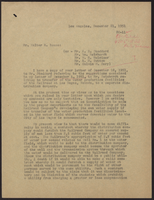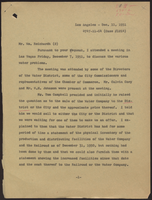Search the Special Collections and Archives Portal
Search Results

Letter from E. E. Bennett (Los Angeles) to William Reinhardt, January 4, 1952
Date
Archival Collection
Description
The Nevada State Engineer suggested that the Las Vegas Valley Water District purchase 1200 acres of "water bearing lands," but the District only wanted to purchase 679 acres.
Text

Letter from E. E. Bennett (Los Angeles) to Walter R. Rouse, December 21, 1951
Date
Archival Collection
Description
Discussion of the Railroad developing its own water supply if the sale to the Las Vegas Valley Water District goes through. The shop well never supplied water to the Las Vegas Land and Water Company, so it would not go to the District.
Text

Letter from W. R. Rouse (Omaha) to A. E. Stoddard, December 18, 1951
Date
Archival Collection
Description
Suggestions that the Railroad should develop its own water so that it will not be subject to rationing as experienced by other water districts. Dividing the water production from all other assets of the Las Vegas Land and Water Company may be the best option for the Railroad to protect its water rights.
Text

Letter from Hugh A. Shamberger (Carson City) to Colonel H. F. Clark (Las Vegas), December 11, 1951
Date
Archival Collection
Description
Shamberger advised the Water District to purchase the lands surrounding the Las Vegas Springs as well as other springs and wells in the area to protect its water sources in the future.
Text

Letter from E. E. Bennett (Los Angeles) to William Reinhardt, December 11, 1951
Date
Archival Collection
Description
The Las Vegas Land and Water Company provided the water district with an inventory a year before, but no buyers made an offer yet. The letter is an account of a meeting to discuss further details of the proposed purchase. "8011-- 174-2 80-Gen." written in red pencil at head of the letter.
Text

Las Vegas Valley Water District Report on water supply, October 1949
Date
Archival Collection
Description
Detailed 76 page report with charts, tables and calculations on the water situation in the Las Vegas Valley.
Text

Letter from Franz A. Maroshek (Las Vegas) to J. M. Murphy (Las Vegas), February 18, 1948
Date
Archival Collection
Description
The County Health Department called on the City Manager to enforce Ordinance 76 to prevent the use of effluent to irrigate land that was used to raise dairy cattle on the Las Vegas Ranch.
Text

Letter from J. M. Murphy (Las Vegas) to Frank Strong (Los Angeles), February 18, 1948
Date
Archival Collection
Description
The Las Vegas City Manager informs Union Pacific Railroad that it would no longer be providing the one million gallons of effluent to the Las Vegas Ranch for use in irrigation.
Text

Letter from A. M. Folger (Las Vegas) to Frank Strong, February 21, 1948
Date
Archival Collection
Description
Discussion of drilling two wells on the Las Vegas Ranch to make up for the irrigation water lost by the City forbidding the use of effluent, and of giving up acreage for the Elks and a sewer treatment plant.
Text

Letter from G. J. Sylvain, M. D. (Las Vegas) to Mr. Folger (Las Vegas), March 28, 1949
Date
Archival Collection
Description
The County Department of Health was going to add oil to the effluent to kill mosquitos, and asked the Las Vegas Land and Water Company to report excess oil running onto their land.
Text
